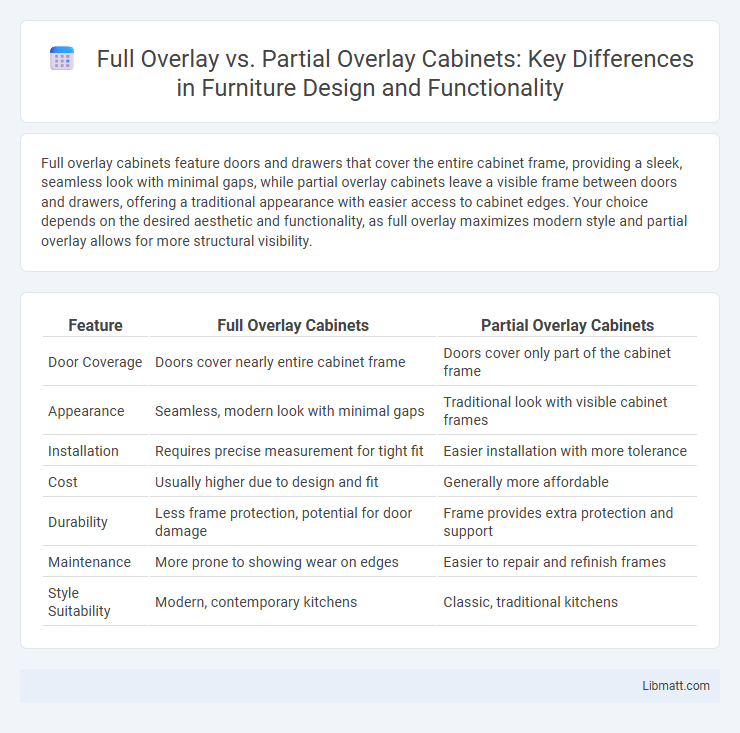Full overlay cabinets feature doors and drawers that cover the entire cabinet frame, providing a sleek, seamless look with minimal gaps, while partial overlay cabinets leave a visible frame between doors and drawers, offering a traditional appearance with easier access to cabinet edges. Your choice depends on the desired aesthetic and functionality, as full overlay maximizes modern style and partial overlay allows for more structural visibility.
Table of Comparison
| Feature | Full Overlay Cabinets | Partial Overlay Cabinets |
|---|---|---|
| Door Coverage | Doors cover nearly entire cabinet frame | Doors cover only part of the cabinet frame |
| Appearance | Seamless, modern look with minimal gaps | Traditional look with visible cabinet frames |
| Installation | Requires precise measurement for tight fit | Easier installation with more tolerance |
| Cost | Usually higher due to design and fit | Generally more affordable |
| Durability | Less frame protection, potential for door damage | Frame provides extra protection and support |
| Maintenance | More prone to showing wear on edges | Easier to repair and refinish frames |
| Style Suitability | Modern, contemporary kitchens | Classic, traditional kitchens |
Introduction to Cabinet Overlays
Cabinet overlays refer to the way cabinet doors and drawers cover the cabinet frame, impacting both style and functionality. Full overlay cabinets feature doors and drawers that nearly cover the entire frame, creating a seamless, modern look with minimal visible gaps. Partial overlay cabinets leave more of the frame exposed, offering a traditional appearance and often providing easier access for hardware and cleaning.
What Are Full Overlay Cabinets?
Full overlay cabinets feature doors and drawer fronts that completely cover the cabinet frame, creating a seamless and modern appearance with minimal gaps between each component. This design maximizes storage space by allowing for larger, uninterrupted surfaces while offering a sleek, streamlined look favored in contemporary kitchens. Full overlay cabinets often require precise manufacturing and installation to ensure consistent alignment and smooth operation of doors and drawers.
Defining Partial Overlay Cabinets
Partial overlay cabinets feature doors and drawer fronts that only partially cover the cabinet frame, leaving a visible reveal between each door and the frame edges. This design creates a traditional, framed look often associated with shaker-style cabinetry and allows for easier installation and adjustments. The visible frame adds structural support and aesthetic detail, distinguishing partial overlay cabinets from the sleek, modern appearance of full overlay cabinets.
Key Differences Between Full and Partial Overlays
Full overlay cabinets feature doors and drawers that cover the cabinet frame entirely, creating a seamless, modern look with minimal gaps and enhanced storage space. Partial overlay cabinets leave a portion of the cabinet frame visible, offering a more traditional appearance while potentially reducing manufacturing costs. Your choice depends on the desired aesthetic and budget, as full overlays provide a sleek design, whereas partial overlays emphasize frame visibility and classic style.
Aesthetic Appeal: Modern vs Traditional Looks
Full overlay cabinets offer a sleek, modern aesthetic with minimal gaps between doors and drawers, creating a seamless and streamlined appearance that enhances contemporary kitchen designs. Partial overlay cabinets provide a traditional look with visible frame edges and more pronounced gaps, adding depth and classic charm to your kitchen space. Choosing between full overlay and partial overlay cabinets depends on your preference for either a modern, clean finish or a timeless, detailed style.
Functional Considerations and Storage Space
Full overlay cabinets offer maximum storage space with doors and drawer fronts covering almost the entire cabinet frame, minimizing gaps for a sleek, modern look that enhances your kitchen's functionality. Partial overlay cabinets provide a traditional aesthetic by exposing more of the cabinet frame, which slightly reduces storage capacity but allows easier access to cabinet edges and hinges. Choosing between full and partial overlay cabinets depends on your prioritization of seamless design versus accessibility and storage optimization.
Cost Comparison: Full Overlay vs Partial Overlay
Full overlay cabinets typically cost more than partial overlay cabinets due to the increased amount of material used and the more precise craftsmanship required for the seamless look. Partial overlay cabinets offer a budget-friendly alternative by exposing parts of the cabinet frame, reducing manufacturing and installation costs. Your choice between full overlay and partial overlay will impact your overall kitchen renovation budget, with full overlay providing a modern aesthetic at a higher price point.
Installation and Hardware Requirements
Full overlay cabinets require precise alignment and often use concealed hinges with soft-close mechanisms for a seamless look, demanding accurate installation and specialized hardware. Partial overlay cabinets install easily with standard hinges and require less precise measurements but expose cabinet frames, impacting hardware choice and installation complexity. Both styles need careful hinge placement, but full overlay demands higher precision to maintain its flush door appearance.
Suitability for Different Kitchen Styles
Full overlay cabinets provide a sleek, modern look with minimal gaps, making them ideal for contemporary and high-end kitchen styles that emphasize clean lines and seamless surfaces. Partial overlay cabinets suit traditional, farmhouse, or rustic kitchens where visible cabinet frames add character and charm, offering a classic and warm aesthetic. Your choice depends on whether you prefer a streamlined, sophisticated appearance or a cozy, timeless kitchen design.
Choosing the Right Overlay for Your Project
Full overlay cabinets provide a sleek, modern look by covering the cabinet frame completely with door and drawer fronts, maximizing cabinet storage space and offering a seamless appearance. Partial overlay cabinets reveal some of the cabinet frame, providing a traditional or vintage style while often being more budget-friendly and easier to install. When choosing the right overlay for your project, consider your aesthetic goals, budget, and the functionality you need in your kitchen or bathroom design to ensure your cabinets enhance both form and function effectively.
Full Overlay vs Partial Overlay Cabinets Infographic

 libmatt.com
libmatt.com